Final report for GNE19-223
Project Information
The tomato leaf mold pathogen Passalora fulva (syn. Cladosporium fulvum) has been studied extensively. Decades of research has given way to greater understanding of plant-microbe interactions. Little is known about the pathogen population diversity in the Northeast, however. With the rise in high tunnel usage for season extension, the fungus is seen more often. Extension specialists are curious about the predominant races of the fungus in order to offer better recommendations to growers regarding resistant varieties.
To answer questions about race, we isolated the fungus from collected leaf samples. After fulfilling Koch’s postulates to confirm that the isolated fungus was the cause of disease, we conducted race determination assays on 35 isolates using a differential set of tomatoes. It was determined that all of the isolates belonged to race 0 and 2. We then sequenced Avr2, Avr4, Avr4e, and Avr9, which are effector genes that interact with plant resistance proteins. When we compared the Avr2 sequences across each isolate, we saw that several isolates were no longer predicted to have functional AVR2 proteins, which is in line with what we saw in our race determination work. Even though the isolates fell into two races, some diversity also existed when comparing the sequence data of the other effector genes as well.
Isolating the fungus from tomato leaf samples was far more challenging than we anticipated, which reduced our isolate collection size. Another interesting observation was that we readily isolated other fungi from the leaf surfaces. The fungal isolates belonged to the genus Cladosporium, yet we couldn’t confirm Koch’s postulates with these isolates. Future work will try to better decipher whether some relationship exists between the causal fungus Passalora fulva and the other Cladosporium species. Despite these early challenges, we can now offer more answers to growers about the predominant races of Passalora fulva in high tunnels. The information can also be helpful as scientists consider how to breed more resistant varieties.
The purpose of my research project was to assist growers in the management of tomato leaf mold through characterization of isolates collected between 2017-2019. The research allowed us to provide recommendations to growers and extension specialists regarding the most resistant tomatoes to grow and whether that pathogen population is diverse.
1) We collected tomato leaf mold samples from high tunnels in the Northeast and isolated Passalora fulva from lesions on foliage. Single conidial isolates were then obtained to ensure that each isolate was genetically distinct.
2) We determined the races of Passalora fulva isolates collected between 2017-2019.
3) Four previously characterized effectors (Avr2, Avr4, Avr4e, and Avr9) were sequenced for each isolate. We aligned sequences to reference sequences, and polymorphisms were identified. We also predicted the effects of the polymorphisms on protein function.
The central goal of the research was to better understand the population diversity of the tomato leaf mold pathogen Passalora fulva in high tunnels. High tunnels have been an important way to extend the growing season of high value crops such as tomatoes. The high tunnel environment is conducive to the growth of the fungal pathogen. Management of the disease is an important consideration in greenhouse and high tunnel production. Passalora fulva is a foliar pathogen, but if the disease becomes too severe, defoliation and yield loss occur. Growers and extension specialists have wondered how diverse the pathogen population is, as they try to manage the disease in high tunnels. Race determination assays and genetic analyses of the pathogen population will have important implications for management. The data will assist growers in choosing resistant varieties of tomatoes to grow. If resistant tomato varieties are planted, fewer fungicides will be needed, and high tunnel production of tomatoes will be more profitable.
Research
In order to complete high tunnel experiments, tomato seed was obtained from the Centre for Genetic Resources in the Netherlands and C. M. Rick Tomato Genetics Resource Center. Tomatoes with no resistance genes (Cf-0) and tomatoes with one resistance gene including Cf-2, Cf-4, Cf-5, Cf-6, Cf-9, or Cf-4 and Cf-11 were included in the differential set. We grew plants to maturity in the spring of 2019 and tomato seed was harvested over the course of several months. Seed was cleaned and stored for future experiments.
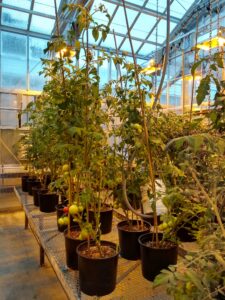
In preparation for race determination experiments, tomato seeds were planted in 50 cell flats in the greenhouse for 4 weeks. Once true leaves appeared, plants were fertilized with All Purpose MiracleGro fertilizer (24-8-16). At four weeks, plants were transplanted in 1-gallon pots and transported to the high tunnel. Plants were stabilized with string woven along the sides of pots and attached to stakes. The recommended amount of slow-release Osmocote (15-09-12) was applied to each pot to ensure that plants were healthy during the time of data collection.
Our high tunnel was covered with weed cloth to suppress weeds. Stakes were placed to demarcate blocks. Tomatoes were put in the high tunnel in pots in order to ensure easy clean-up and fast-turn around in between experiments. In the past, we’ve planted tomatoes successfully in the high tunnels, but the potted experiment was necessary in order to get through many experiments during the growing season and also to ensure less possible cross-contamination of isolates.
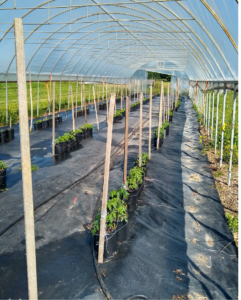
The high tunnel fit 26 blocks, as well as a control block. Within each experiment, single isolates were used as inoculum for two blocks each. Thirteen isolates in total could be tested at once. The blocks were randomized, and each genotype within a block was also randomized. Control plants were also included in the experimental design.
Meanwhile, isolates were sent to us from extension specialists in the Northeast during the 2019 growing season to add to our collection of isolates from 2017 and 2018. Single conidial isolations were prepared for each isolate and afterwards, isolates were stored in 30% glycerol stocks for safe-keeping.
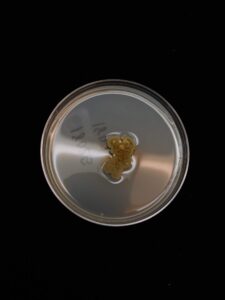
Inoculum was prepared in clean ½ gallon handheld pressure sprayers. Inoculum was dispersed onto tomatoes so that each leaf contained an even distribution of inoculum, with care to sanitize hands in between inoculations with different isolates. The inoculum concentration was approximately 2.5x105 conidia/ml. After 14 days, symptoms and signs appeared, and we rated plants. Symptoms and signs emerged first on older leaves, before progressing upward. Clear signs and symptoms were seen on tomatoes that were susceptible. As an added control, in several instances, the fungal pathogen was reisolated onto media to ensure that the pathogen was indeed present on symptomatic leaves. If there were any discrepancies between replicated blocks, isolates were again used as inoculum in a subsequent experiment.
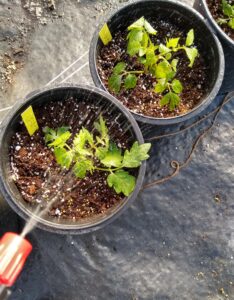
In order the amplify and then sequence the effector genes, primer sequences were obtained from previous publications (Medina et al. 2015, Iida et al. 2015). Emerald Amp GT PCR Master Mix (Takara) was used. For each reaction, 0.5 ml of the forward and reverse primers, 12.5 ml of master mix was used and 9 ml deionized water were combined. For each 22.5 ml reaction, 2.5 ml of template DNA was added for a final reaction volume of 25 ml. After amplification in the Bio-Rad C1000 Touch Thermal Cycler, Sanger sequencing of all PCR amplicons was conducted at Cornell Institute of Biotechnology in the Genomics Facility, and samples were prepared according to their specifications. PCR conditions were described previously (Stergiopoulos, de Kock, et al. 2007). The sequence data was analyzed in Geneious Prime 2020.2.2, with sequence alignments performed using MUSCLE 3.8.425 relative to previously published reference sequences. The coding regions were translated and compared to protein predictions of reference sequences, in order to predict the effects that the polymorphisms might have at the protein level.
Race assays occurred during the summers of 2018-2020. Race assays were conducted on the 35 isolates collected in the Northeast. 29/35 isolates showed disease symptoms on tomatoes containing Cf-0 and Cf-2. The race designation of these isolates is race 2. The remaining isolates only showed disease symptoms on tomatoes with Cf-0, including 5 isolates from New York, and one isolate from Massachusetts, resulting in a race designation of race 0.
After sequencing Avr2, Avr4, Avr4e, and Avr9, we took note of polymorphisms relative to reference sequences. While few polymorphisms exist, Avr2 showed the greatest number of polymorphisms. We noted three polymorphisms within the coding region, and one polymorphism in the non-coding region. Two deletions in the coding region resulted in frameshift mutations. In addition, three isolates from 2019 had large deletions spanning much of the coding region. Interestingly, seven isolates could not be amplified with the primers used. For Avr4, no SNPs was located within the non-coding region. With Avr4e, two SNPS exist within the coding region, resulting in two potential nonsynonymous substitutions. For Avr9, one SNP was identified within the coding region, resulting in another predicted nonsynonymous substitution.
Working with the fungus wasn’t very easy initially, but over time, it became easier to isolate the causal fungus. Mysteries still exist between the close association between other fungal species that are readily isolated on tomato leaf surfaces. We will try some follow-up experiments to try to better understand if a relationship might exist between the causal fungus and these other Cladosporium species.
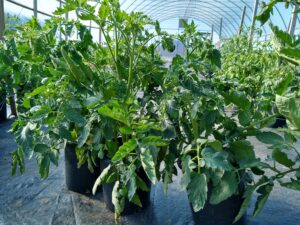
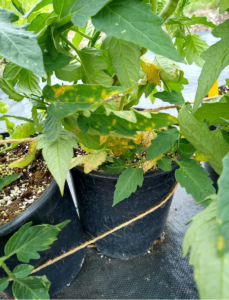
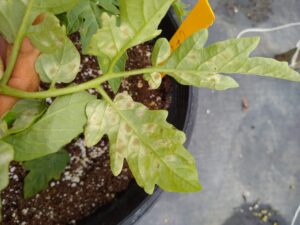
The key takeaway is that isolates collected in the Northeast belong to two predominant races: 0 and 2. It is still important to be aware that while the fungus is not known to reproduce sexually, some genetic differences exist between isolates, including within genes encoding effector proteins that interact with plant resistance proteins, across different isolates. If growers plant tomato varieties with the same underlying Cf resistance genes, the pathogen population will likely overcome resistance. Care should be taken to plant varieties that contain a diverse set of resistance genes. In turn, growers will see less disease. Fewer chemical inputs will be needed in high tunnels.
Based on our research, susceptible tomatoes most likely contain no Cf resistance genes or the Cf-2 resistance gene. Based on the polymorphisms we saw in the coding regions of Avr2 effector gene, much of the pathogen population in the Northeast is likely able to overcome resistance to tomatoes containing the tomato resistance gene Cf-2. It would be best to locate tomato varieties with the resistance genes Cf-4, Cf-5, Cf-6, Cf-9, or Cf-4 and Cf-11. By growing resistant varieties, fewer fungicide inputs are necessary, leading to lower costs and greater sustainability.
Education & Outreach Activities and Participation Summary
Participation Summary:
I wrote and revised a tomato leaf mold fact sheet. In 2020, it was made available online and in print. The PDF version is ADA-compliant.
https://www.vegetables.cornell.edu/crops/tomatoes/tomato-leaf-mold/
I also prepared both a manuscript on my tomato leaf mold research and presentation slides for academic and extension audiences.
Project Outcomes
I hope my work will help pave the way for future for sustainable agriculture research work in high tunnels, and also with regards to management of the tomato leaf mold pathogen Passalora fulva. High tunnels are an important asset to growers who rely on season extension of high value crops such as tomatoes. My project provided more detailed information on the type of resistance needed to withstand the Passalora fulva pathogen population in the Northeast. Planting resistant varieties of plants is a sustainable disease management strategy, but care needs to be taken to include tomatoes with several different resistance genes.
The project gave me the independence to design and complete a project that I was excited about. The project allowed me to gain skills running a high tunnel experiment over several years, and to gain confidence working with a challenging pathosystem. As I combined the results from the race determination work with results obtained from sequencing effector genes, and interesting story emerged. I hope to continue to improve my research skills during postdoctoral work and eventually, I’d like to find a job that includes both teaching and research components. I hope to prioritize sustainable agriculture projects.
Planting resistant varieties of plants is an important disease management tool. Planting resistant varieties is an important way to manage disease, but it is also important to think about strategies to ensure that pathogen populations don't overcome resistance too quickly. This is something I thought about often during the project.
This project was an important step towards understanding the population diversity of Passalora fulva, the causal agent of tomato leaf mold, and the interplay with particular resistance genes in tomatoes. To better understand pathogen diversity, I recently performed genotyping-by-sequencing of the isolates that I collected during this project. Paired with the race determination work and effector results, I was better able to understand the diversity that exists between isolates. Sexual reproduction has not been observed in this fungus, but in my examination of the GBS data, I saw that isolates were not just part of a single clonal population. A follow-up study, with additional isolates over several more years, would offer more insights about how the pathogen population is changing over time. The SARE grant allowed us to build a strong foundation for future work.
I had hoped to compare the results of my work to race assays on several susceptible and resistant tomato varieties that are commonly grown by high tunnel growers. This would be a helpful follow-up. Unfortunately, the field season was shortened this year, due to the pandemic. I didn't have time to complete this step in 2020. Still, much was learned from the research enabled by SARE.
Another challenge was that information is not readily available about particular Cf genes in modern tomatoes, making it hard to know for sure what the underlying basis of resistance to tomato leaf mold is in modern tomatoes, but much can be gleaned from literature from the 1900s.
Information Products
- Tomato Leaf Mold Fact Sheet (Fact Sheet)